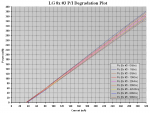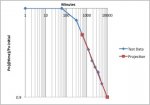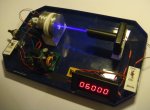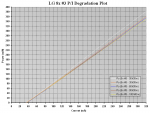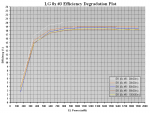The diode succesfully reached 100 hours ON-Time two days ago. Still alive and kicking! :yh:
This was a very special moment worthy of another photo:
It was only 10h since the previous tests, but since i had a feeling degradation was speeding up i was more careful, and wanted to replot more often.
Strangelly, the result was this:
Same power at high currents, but a tiny bit higher power at lower currents! :thinking:
Similar to what i noticed the previous time!
This is even more noticable in the efficiency plot. At the lower powers, the efficiency is higher:
As you can see, the efficiency lines cross, as the later ones exceed the earlier ones at low currents.
And i matched the temperatures as accuratelly as i could, went back and forth a couple of times, checking the meter is zeroed in, the data is accurate....
It's just a little weird that efficiency would climb at lower currents.
Seems a very strange effect for degradation. At higher currents, the power does drop with time, even tho from 90 to 100h this didn't happen.
The strange efficiency behavior is why i cleaned up the plots. I left only the ones spaced 30h appart, and the last one of course, to show how it compares to the previous one (starts higher, ends the same).
Now that the unevenly spaced plots were removed, it is suddenly very apparent, how the first 30 hours had a larger impact than the remaining 70 together!
One thing i can't understand is, why degradation is not noticable in 10h, but can be huge in 20 or 30h... It's not the first time this happened.
I guess we'll see at 120h. The show must go on.
Diode Stats:
- Ith = 36mA
- Po @ 300mA = 325.5mW (Same as at 90h)
- Slope Efficiency = 1.233mW / mA Avg. (Same as at 90h)
- Actual Efficiency = 18.53% Peak / 18.26 Avg. (Higher than before?!? :thinking

Looking at the old data, both the average and the peak efficiencies are higher than they were before.
This does not make much sense.
I'm starting to think that using the Vf to make sure the temperature is the same is not good enough here. It's quite possible changes happen to the Vf of the diode as it degrades as well. The Vf definitelly changes, when diodes die...
Because of this the second 8x Murder candidate (and the 12x) will have a micro temperature sensor soldered directly onto the bottom of the diode can, and i will use that sensor to make sure the temperatures are the same during all plots (instead of the temperature sensor in the heatsink - too much lag, which is why i used the Vf instead).
Now i have a problem tho. I don't want to stop this experiment because it's the first time i am recording the death of a diode in this much detail. In all previous experiments, all i did was measure the time until death, well power sometimes too, but i didn't make accurate logs of the changes.
The reason i want the bitter end recorded is, that it could tell me what to expect from the second diode, OR the second diode would show that they die much differently from one another, in either case i want to know.
The problem is, while i have the second sensor/counter almost ready, i got them for the 12x experiment.
And now since this diode doesn't want to die, i might have three live diodes at once. And only two counters.
I could probably have had this diode dead by now if i left it running last week, but i was away a lot because of work, and i really didn't want to leave it unattended.
At the same time, i really want to start the second 8x experiment. I should have picked up another counter while i was in Conrad...
I could run one experiment on a time recorder only, but without visual feedback i won't know when to re-plot it. Looks like i need to check local shops for counters, altho i doubt i'll find them. :undecided:
In any case, this diode has surpassed all my expectations by far!
Hopefully it can only get better from this point on, but i guess we'll see (which is why i'm so anxious about the second one!)...





